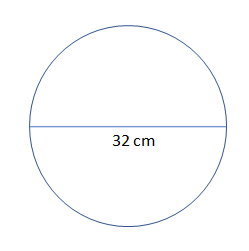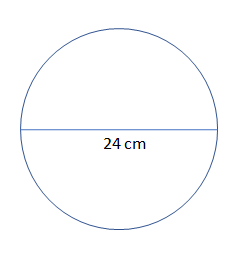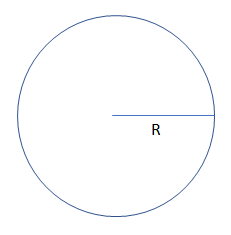
The diameters of the two circles are 32 cm and 24 cm. Find the radius of the circle having its area equal to the sum of the areas of two given circles.
Answer
512.7k+ views
1 likes
Hint: First, before proceeding for this, we must draw the two circles with diameters as 32 cm and 24 cm to get a clear picture of the new circle radius Then, , by using the concept of property of the circle which states that radius of the circle is half of the diameter, we get the radius of both circles. Then, by using the condition given in the question as the new circle area A is the summation of two given circles areas
Complete step by step answer:
In this question, we are supposed to find the radius of the circle having its area equal to the sum of the areas of two circles with diameters 32 cm and 24 cm.
So, before proceeding for this, we must draw the two circles with diameters as 32 cm and 24 cm to get a clear picture of the new circle radius required as:


Then, by using the concept of property of the circle which states that radius of the circle is half of the diameter.
So, by using this property, we get the radius
Similarly, by using the same property, we get the radius
Now, let us suppose that the area of the circle which is required and given as the summation of the area of above two circles has the radius R.

So, by using the condition given in the question as the new circle area A is the summation of two given circles areas
Then, by substituting the value of the area of both the given circles and new circle as:
Then, by substituting the value of
Hence, we get the radius of the new circle as
Note: Now, to solve these types of questions we need to know some of the basic formulas beforehand so that we can easily proceed in these types of questions. Then, some of the basic formulas related to circle are:
Area of the circle is given by
Complete step by step answer:
In this question, we are supposed to find the radius of the circle having its area equal to the sum of the areas of two circles with diameters 32 cm and 24 cm.
So, before proceeding for this, we must draw the two circles with diameters as 32 cm and 24 cm to get a clear picture of the new circle radius required as:


Then, by using the concept of property of the circle which states that radius of the circle is half of the diameter.
So, by using this property, we get the radius
Similarly, by using the same property, we get the radius
Now, let us suppose that the area of the circle which is required and given as the summation of the area of above two circles has the radius R.

So, by using the condition given in the question as the new circle area A is the summation of two given circles areas
Then, by substituting the value of the area of both the given circles and new circle as:
Then, by substituting the value of
Hence, we get the radius of the new circle as
Note: Now, to solve these types of questions we need to know some of the basic formulas beforehand so that we can easily proceed in these types of questions. Then, some of the basic formulas related to circle are:
Area of the circle is given by
Latest Vedantu courses for you
Grade 11 Science PCM | CBSE | SCHOOL | English
CBSE (2025-26)
School Full course for CBSE students
₹41,848 per year
Recently Updated Pages
Master Class 12 Business Studies: Engaging Questions & Answers for Success

Master Class 12 English: Engaging Questions & Answers for Success

Master Class 12 Economics: Engaging Questions & Answers for Success

Master Class 12 Social Science: Engaging Questions & Answers for Success

Master Class 12 Maths: Engaging Questions & Answers for Success

Master Class 12 Chemistry: Engaging Questions & Answers for Success

Trending doubts
Which one is a true fish A Jellyfish B Starfish C Dogfish class 10 biology CBSE

The Equation xxx + 2 is Satisfied when x is Equal to Class 10 Maths

Gautam Buddha was born in the year A581 BC B563 BC class 10 social science CBSE

Fill the blanks with proper collective nouns 1 A of class 10 english CBSE

Why is there a time difference of about 5 hours between class 10 social science CBSE

What is the median of the first 10 natural numbers class 10 maths CBSE




